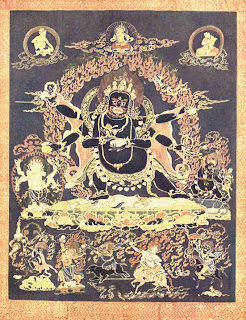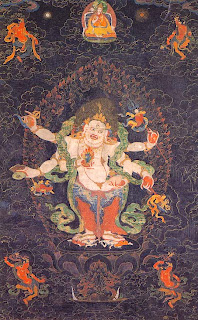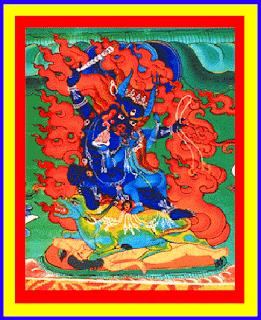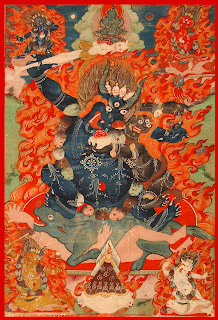
The
Dharmapalas are the defenders of the Law of Buddhism who are entrusted with the
work of destroying all enemies of Buddhism. They are also called the Drag-Ched
or 'T he Eight Terrible Ones' and their ferocious forms are mainly to inspire
evil spirits with fear. Each sect in Tibet has a terrible defender for
protecting the devotees from the dangers of evil powers and restraining them
from evil acts. The thankas depicting Dharmapalas belong to the group of mGon
k' an. i.e., Lords' house which means the `Yi-dam' or the protecting deity of
the sect and a number of ferocious aboriginal deities who were included in the
Lamaistic pantheon as 'Terrible Keepers of the Law'. These thankas are characterized
by dark or black figures of monstrous deities delineated against a dark
background and surrounded by flames. The Dharmapalas are re-presented with
crown of skulls, disheveled hair, triple eyes scowling eye brows, garment of
tiger, elephant or human skin, garland of severed heads ornaments and aprons
made of human bones and snakes, and trampling human beings or animals. These
terrible Defenders of the Law exhibit their wrathful aspects out of compassion
towards people to frighten evil forces so that they follow the path of Buddhism
and attain liberation.
Mahakala,
a prototype of Siva is one of the Hindu deities which has been incorporated
into the Buddhist pantheon. The worship of Mafia-Lila is generally meant for
Tantric rite of mantra.
Mahfikala
(Gur-gui-Gam-Po) as Lord of the tent and with his magic staff placed across his
arms is also called Danda Mahakala in Tibet. He looks terrible with three
rolling eyes, red gaping mouth, scowling eye brows, flaming hair, protruding
belly and ornaments of snakes. His matted hair rises over the head surmounted
by a vajra. The god is short, wearing tiger-skin and trampling upon a human corpse.
He is decorated with a garland of severed heads and wears crown that consists
of five skulls. Mahakala is here represented in his two-armed manifestation
holding kartri in the right hand and kapala in the left hand.
 At
the top, in the centre, is Adi Buddha Vajradhara holding vajra and ghanta
across the chest in vajrahumkaramudra. On his right and left sides are
portrayed Chogyal Phagpa, the preceptor of Sakyapapdita in meditating posture
and Sakyapandita, one of the great teachers of the Sakya School wearing red cap
and showing the vitarkamudra. Mahakala is encircled by three of the mahapancaraja
namely, Pe-har, Cho-chyong, Dalha, all in militant attitude holding khadga, danda,
pasa, kartri, khakkara, kaPala, etc. The one on his right, a seated figure
holding ambrosia vase in two hands and decked in celestial dress and ornaments
probably represents a form of Mahakala, while the other on his left is Lha-mo
or SrIdevi riding a mule with an eye on its haunch and carrying in her four
hands the khadga, kapala, Sula and trisula.
At
the top, in the centre, is Adi Buddha Vajradhara holding vajra and ghanta
across the chest in vajrahumkaramudra. On his right and left sides are
portrayed Chogyal Phagpa, the preceptor of Sakyapapdita in meditating posture
and Sakyapandita, one of the great teachers of the Sakya School wearing red cap
and showing the vitarkamudra. Mahakala is encircled by three of the mahapancaraja
namely, Pe-har, Cho-chyong, Dalha, all in militant attitude holding khadga, danda,
pasa, kartri, khakkara, kaPala, etc. The one on his right, a seated figure
holding ambrosia vase in two hands and decked in celestial dress and ornaments
probably represents a form of Mahakala, while the other on his left is Lha-mo
or SrIdevi riding a mule with an eye on its haunch and carrying in her four
hands the khadga, kapala, Sula and trisula.
At
the bottom of the thanka five messengers of Mahakala have been depicted, all in
dancing pose holding sword, magic stick, skull cup and knife, etc.
In
this thanka the whole composition is done in bold lines against a black
background and the color plays an insignificant role.
Begtse
which literally means 'hidden sheet of mail' is a god of war and as a
Dharmap5la he ruthlessly destroys the enemies of Buddhism. He is standing on
lotus stepping his right leg on a blue horse and left leg on human being.
Begtse is usually believed to be a Mongol god and a late incorporation in the
Lamaistic pantheon. According to a Mongolian legend when the third Dalai Lama
(1543-1589) was invited by the king Altan Khan to convert the Mongols, Begtse
with an army of demons in the form of animals appeared before him. The Dalai
Lama then assumed the form of Avalokitesvara and the hoofs of his horse left
the imprints of the mantra 'om manipadme hum' and Begtse was converted to
Buddhism. He is portrayed ferocious with three scowling eyes, copper helmet,
cuirass, Mongolian boots and girdle of heads. With his right hand he brandishes
a copper sword while his left hand holds the heart of the enemies to his mouth.
 Begtse
is here shown in the company of his sister Rig pai Lha mo riding on a lion, who
has a blue face, red body, and is holding sword and phur-bu in two hands, while
on his right side is represented a warrior carrying lance and noose in two
arms. Begtse is therefore usually called 'lcam srin' i.e., brother and sister.
Begtse
is here shown in the company of his sister Rig pai Lha mo riding on a lion, who
has a blue face, red body, and is holding sword and phur-bu in two hands, while
on his right side is represented a warrior carrying lance and noose in two
arms. Begtse is therefore usually called 'lcam srin' i.e., brother and sister.
At
the top, in the centre, is represented Dhyani Buddha Amitabha flanked by great
Guru Padmasambhava and Bodhisattva Vajrapani. At the bottom he is encircled by
eight acolytes, all in an agitated mood and holding sword and kapala. Begtse
is also said to reside in a cemetery. The figures of dakinis holding entrails,
bones, torn out eyes, etc. along with flying vultures feasting with entrails
and wild animals give an idea of charnel ground visualizing the old nomad god
as Defender of the Law and a subject of meditation in the charnel field.
Yama,
commonly known in Tibetan as Gsin rje or Chos-gyal, king and god of death, is
represented with buffalo head, three rolling eyes, flaming eye brows and two
arms. He is riding a buffalo on lotus in pratyalidha pose, the latter trampling
a man. He wears naramundamala (garland of human heads) and a snake thread and
on his breast is the emblem of wheel, a distinctive mark given by Tsong-kha-pa
for appointing him as protector of the Ge-log-pa sect or Yellow Bonnets. The
god wears a crown consisting of skulls and his hair with vajra rises in the
shape of flame. In his right arm he holds sceptre topped by skull (yamadanda)
while in his right arm he holds noose (pasa).
Yama
is accompanied by his sister Yami holding trisula and kapala with blood in her
right and left hands respectively.
At
the bottom a separate piece of cloth representing skull heads is attached with
the thanka.
This
large thanka represents Yama, the king and judge of the dead (Dharmaraja) with
his sister Yami. Encircled by flames Yama in his exoteric form is portrayed
with buffalo head, and standing in pratyalidha pose on his mount buffalo who is
trampling a human figure in an agitated attitude. His three scowling eyes,
flaming hair, curved long nails and his pratyalidha pose, all manifest an
expression of great anger. He is nude and decked in ornaments of bones (sanmudra)
and naramundamala and his diadem is decorated with skulls and jewels surmounted
by a vajra. He is two armed. With his right arm he carries the command staff
(dada) topped by skull and banner and with his left hand in tarjanimudra he
holds pasa. On the left side of Yama, Yami, his sister is represented in the same
terrific expression, offering blood in a kapala to his mouth and holding
trident (trisula).
At
the top, in the centre, is represented Adi Buddha Vajradhara and his sakti in yab-yum
flanked by Atisa, the great Indian monk and founder of the Ka-dam-pa sect and
Tsong-kha-pa, follower of Atisa and founder of the Ge-lug-pa sect. It was
Tsong-kha-pa who appointed Yama as protector of the Yellow cap sect. In the
lower section of the thanka is portrayed Lha-mo, the only feminine .divinity
among the eight Dharmapalas who is regarded as the chief protectress of the
Ge-lug-pa sect. She is accompanied by Pe-har, the chief of the Four Great Kings
(mahapancaraja) riding a lion and wearing broad-brimmed hat on the right and
Begtse riding a blue horse on the left. Both of them are worshipped as
protectors of the faith by the Ge-lug-pa sect. Besides, two skull-cups have
been depicted representing gruesome offering of five senses and offering of fat
in two skull-cups placed on smaller skulls as tripod.
Writer – Sipra Chakraverti
Read Also:
 At
the top, in the centre, is Adi Buddha Vajradhara holding vajra and ghanta
across the chest in vajrahumkaramudra. On his right and left sides are
portrayed Chogyal Phagpa, the preceptor of Sakyapapdita in meditating posture
and Sakyapandita, one of the great teachers of the Sakya School wearing red cap
and showing the vitarkamudra. Mahakala is encircled by three of the mahapancaraja
namely, Pe-har, Cho-chyong, Dalha, all in militant attitude holding khadga, danda,
pasa, kartri, khakkara, kaPala, etc. The one on his right, a seated figure
holding ambrosia vase in two hands and decked in celestial dress and ornaments
probably represents a form of Mahakala, while the other on his left is Lha-mo
or SrIdevi riding a mule with an eye on its haunch and carrying in her four
hands the khadga, kapala, Sula and trisula.
At
the top, in the centre, is Adi Buddha Vajradhara holding vajra and ghanta
across the chest in vajrahumkaramudra. On his right and left sides are
portrayed Chogyal Phagpa, the preceptor of Sakyapapdita in meditating posture
and Sakyapandita, one of the great teachers of the Sakya School wearing red cap
and showing the vitarkamudra. Mahakala is encircled by three of the mahapancaraja
namely, Pe-har, Cho-chyong, Dalha, all in militant attitude holding khadga, danda,
pasa, kartri, khakkara, kaPala, etc. The one on his right, a seated figure
holding ambrosia vase in two hands and decked in celestial dress and ornaments
probably represents a form of Mahakala, while the other on his left is Lha-mo
or SrIdevi riding a mule with an eye on its haunch and carrying in her four
hands the khadga, kapala, Sula and trisula.  Begtse
is here shown in the company of his sister Rig pai Lha mo riding on a lion, who
has a blue face, red body, and is holding sword and phur-bu in two hands, while
on his right side is represented a warrior carrying lance and noose in two
arms. Begtse is therefore usually called 'lcam srin' i.e., brother and sister.
Begtse
is here shown in the company of his sister Rig pai Lha mo riding on a lion, who
has a blue face, red body, and is holding sword and phur-bu in two hands, while
on his right side is represented a warrior carrying lance and noose in two
arms. Begtse is therefore usually called 'lcam srin' i.e., brother and sister.













0 Response to "Dharmapalas or Protectors of The Law "
Post a Comment